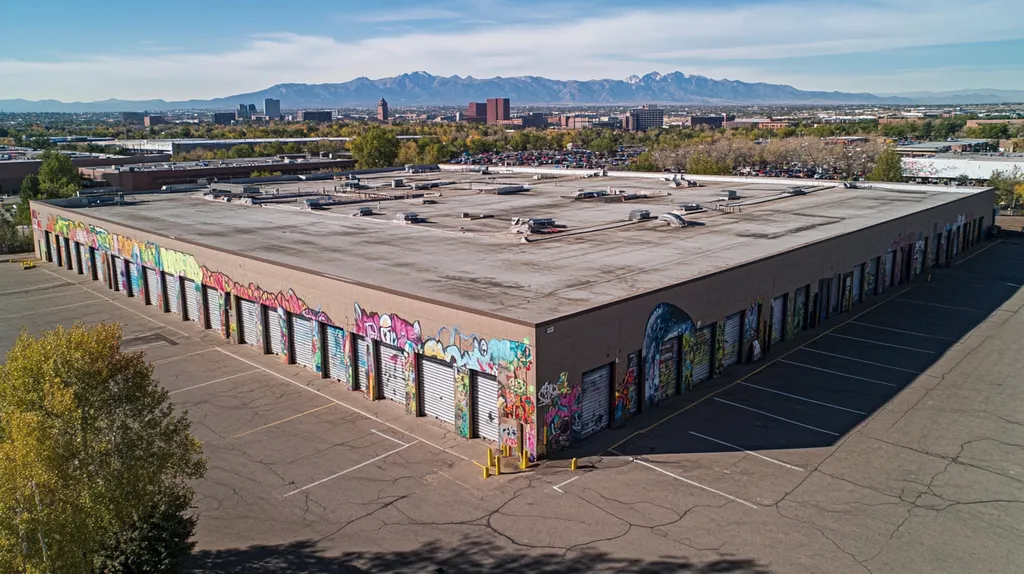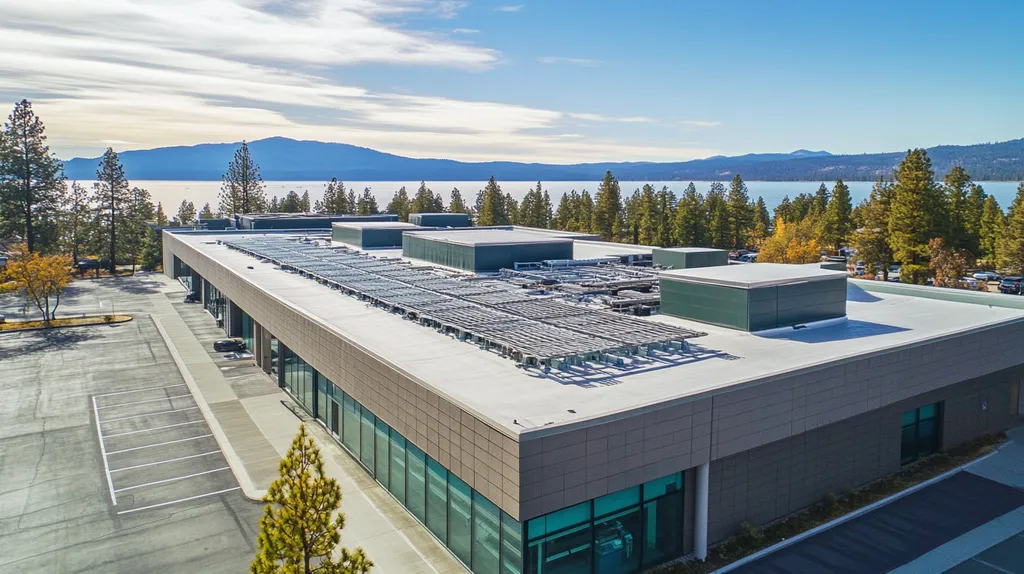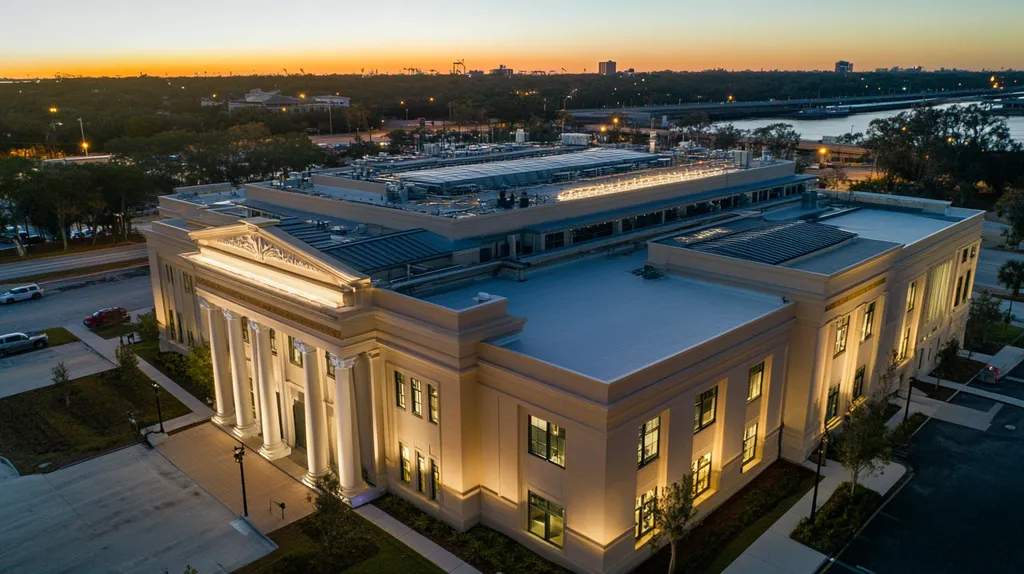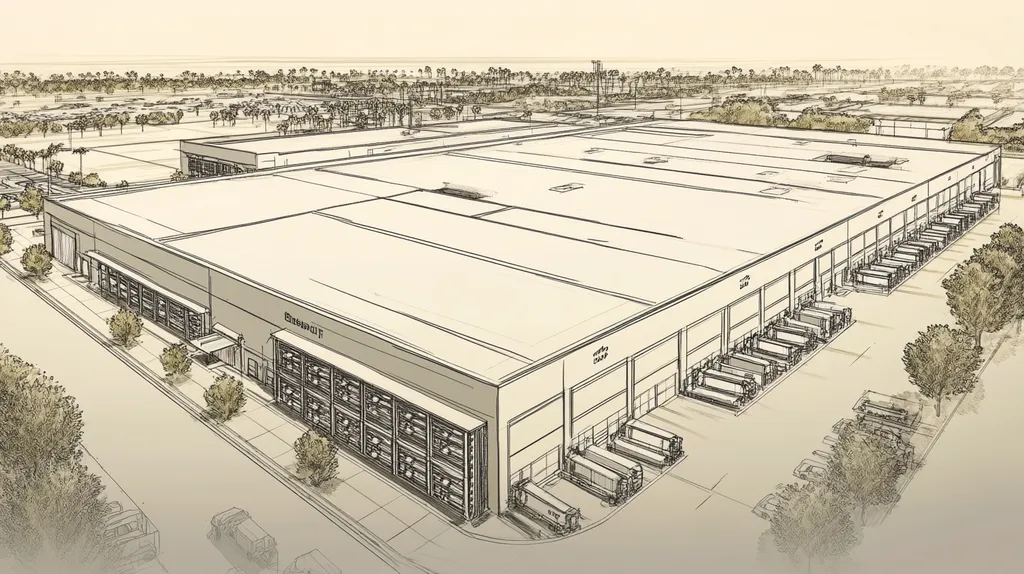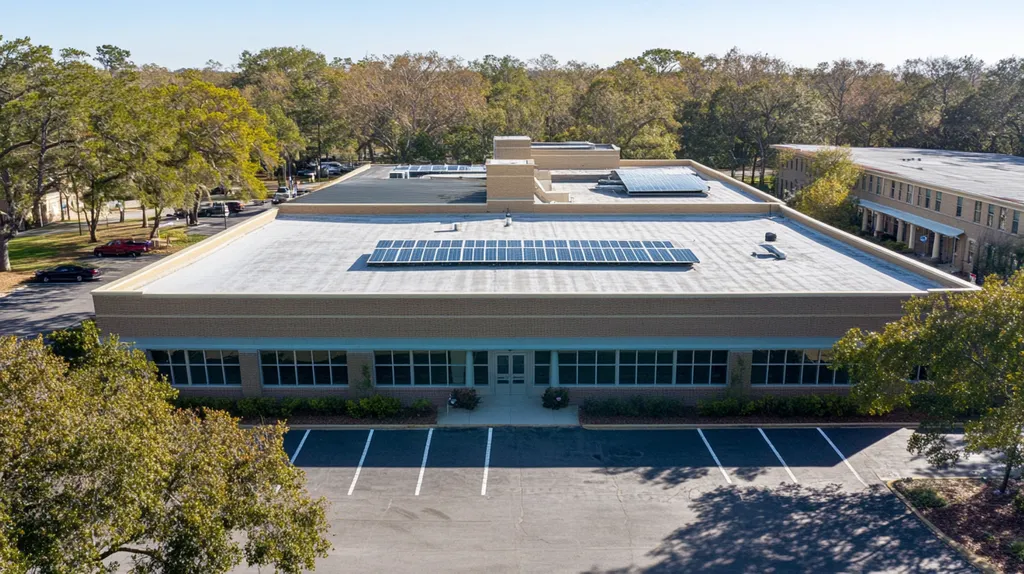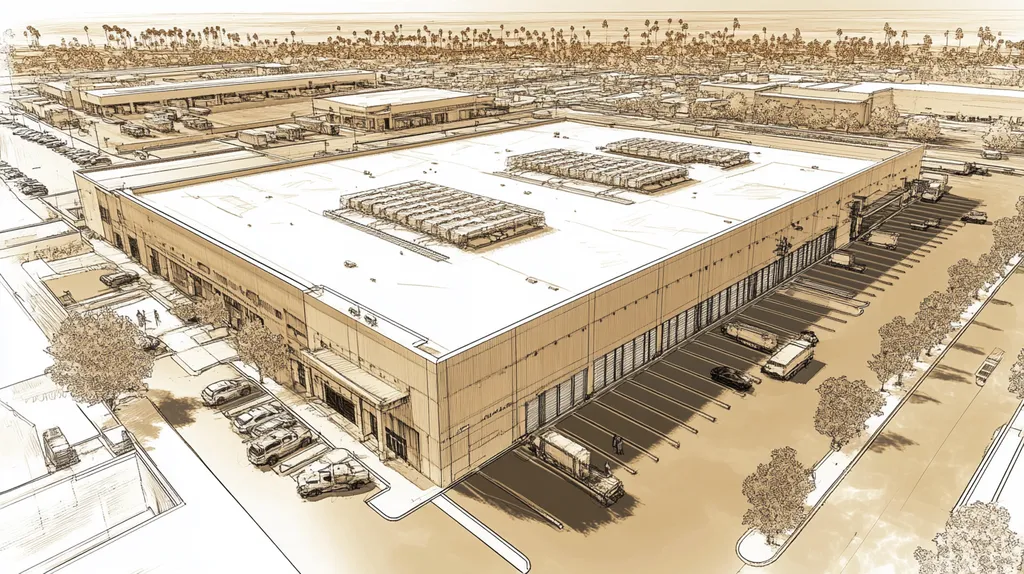Each year, thousands of preventable accidents occur on commercial roofs, resulting in devastating injuries and millions in liability costs. According to OSHA statistics, falls from heights remain the leading cause of fatalities in the construction industry, with 36% of deaths attributed to roof-related incidents.
For facility managers, understanding proper accident procedures isn’t merely about compliance—it’s about preventing catastrophic outcomes that can cripple operations and destroy lives.
This comprehensive guide examines common misconceptions about roof safety, explores the practical implications of proper accident protocols, and provides evidence-based solutions for protecting both workers and assets.
SECTION 1: COMMON MISCONCEPTIONS
Safety on commercial roofs is a critical concern that is often underestimated, putting both workers and property at serious risk. Alarmingly, the National Safety Council indicates that falls make up nearly 40% of fatalities within the construction industry. It is essential for facility managers and property owners to grasp the myths surrounding roof safety protocols, DIY inspections, and hazard risks in order to safeguard their investments and personnel.
Ignoring Safety Protocols
A common misconception among facility managers is the notion that safety protocols are merely suggestions. This dangerous assumption can lead to hazardous conditions, especially during maintenance or inspections. For example, neglecting to use proper personal protective equipment (PPE) significantly increases the risk of falls and injuries.
Failure to comply with established safety protocols heightens the likelihood of accidents. Industry regulations mandate fall protection systems, and overlooking this requirement can expose businesses to substantial legal repercussions. The financial implications of such oversights can lead to increased costs and rising insurance premiums.
In addition, lack of regular safety training can leave employees unprepared for emergencies. A well-trained team is equipped to respond effectively in critical situations, which can ultimately save lives. Regular training reinforces the importance of adhering to safety protocols and developing appropriate response strategies.
Moreover, neglecting these protocols communicates a troubling message regarding the organization’s commitment to employee safety. Cultivating a robust safety culture not only protects the workforce but also enhances the company’s reputation and operational efficiency.
DIY Roof Inspections
Some facility managers may be tempted to conduct their own roof inspections to cut costs. However, this approach can lead to significant oversights that may result in costly damages or injuries. Professional inspectors possess specialized training to identify potential hazards and issues that an untrained eye might easily overlook.
For instance, inexperienced inspectors might miss critical indicators of roof deterioration, such as subtle water stains or unusual wear patterns. Neglecting these warnings could lead to severe problems, necessitating extensive repairs and potentially creating unsafe conditions.
Additionally, improper inspection methods can compromise the integrity of the roofing system. Certain areas may require specialized knowledge for appropriate assessment, and relying on unqualified personnel can increase liability risks should an accident occur during these inspections.
Thus, the financial investment in a professional inspection is minor when compared to the potential costs of neglecting roof maintenance. Collaborating with qualified roofing experts ensures comprehensive evaluations and long-term protection of commercial properties.
Underestimating Hazard Risks
Many property owners mistakenly downplay the risks involved in roof work, often perceiving maintenance as a low-risk activity. However, hazards such as falls, equipment failures, and adverse weather conditions pose significant risks to workers performing roof tasks.
An accidental misstep on a sloped surface, for example, can result in severe injuries or fatalities. The Occupational Safety and Health Administration (OSHA) enforces strict guidelines for roofing activities, underscoring the dangers present in seemingly routine tasks. Disregarding these risks is not just negligent but can also have dire consequences.
Furthermore, changing weather conditions can dramatically influence roof safety. High winds or wet surfaces transform routine maintenance into a perilous undertaking. Facility managers must remain vigilant and proactive, taking these variables into account when planning roof work.
Ultimately, fostering a culture of hazard awareness is crucial in reducing accident likelihood. By conducting thorough risk assessments and recognizing potential dangers, property owners can implement proactive measures that enhance both safety and overall operational performance.
SECTION 2: PRACTICAL IMPLICATIONS
Accidents on commercial roofs can lead to devastating injuries and hefty lawsuits. According to the Occupational Safety and Health Administration (OSHA), tens of thousands of workplace accidents happen annually, with roofing tasks ranking among the most dangerous. To protect their assets and workforce, property owners and facility managers must prioritize understanding and implementing effective procedures for these incidents. This section will address the importance of compliance with OSHA regulations, the positive impact on workplace safety, and the dire consequences of neglecting proper training.
Compliance with OSHA Regulations
OSHA establishes strict standards aimed at safeguarding workers in hazardous environments, including commercial roofs. Facility managers must ensure that their roofing operations adhere to these regulations to minimize risk. Non-compliance can result in hefty fines and increased scrutiny from regulatory organizations.
For instance, failing to provide adequate fall protection may lead to penalties reaching thousands of dollars. Additionally, inadequate safety measures not only endanger workers but also tarnish a company’s reputation and financial stability. Keeping staff updated through regular training sessions on these safety regulations is vital for all employees engaged in roofing tasks.
Maintaining accurate records of safety audits and training completion is another essential aspect. Documenting compliance with OSHA standards demonstrates a commitment to safety, protecting employees and preparing the organization for inspections.
In conclusion, achieving compliance with OSHA regulations is imperative. This commitment plays a critical role in reducing accidents and fostering a culture of safety within the workplace.
Impact on Workplace Safety
Implementing effective accident procedures greatly enhances overall workplace safety. A well-defined protocol ensures that all team members are prepared to respond swiftly during an incident, thus minimizing chaos and confusion. For example, having a clearly articulated emergency response plan can significantly decrease response times, potentially saving lives.
Safety equipment, such as harnesses and guardrails, reinforces the organization’s commitment to worker well-being. Regularly scheduled safety drills and training simulations cultivate a proactive culture, empowering employees to protect not just themselves, but their colleagues as well. These initiatives contribute to a safer working environment.
Moreover, companies with robust safety protocols often experience lower insurance premiums. Insurers classify these firms as lower-risk, which translates into overall financial benefits. Investing in training and safety measures can lead to long-term savings while simultaneously raising safety standards.
Ultimately, prioritizing workplace safety through efficient accident procedures fosters a positive work environment, boosts employee morale, and enhances productivity.
Consequences of Neglecting Training
Overlooking training on accident procedures can lead to severe repercussions for both employees and the organization. Inadequate preparation heightens the risk of mishandling accidents, resulting in more severe injuries or even fatalities. Such incidents can expose organizations to substantial legal liabilities and fines.
Furthermore, not investing in training can diminish employee confidence. Workers may feel ill-equipped to handle emergencies, leading to hesitance during critical situations. This can compound trauma and adversely affect the mental health of the workforce.
Failing to prioritize training sends a troubling message to employees, implying that their safety is not valued. This decreased morale can contribute to high turnover, as employees seek out organizations that prioritize safe working conditions. A disengaged workforce often results in lower productivity, directly impacting the company’s financial performance.
Conversely, committing to regular training enhances employee knowledge and fosters a genuine culture of safety. This commitment signals that management values its workforce, leading to a more cohesive and motivated team.
SECTION 3: COST OF MISINFORMATION
Misinformation in commercial roofing can lead to substantial financial repercussions. Studies reveal that property owners may incur unexpected costs of up to 30% more due to mishandled accident protocols. With such significant stakes, it is crucial for facility managers to be armed with accurate information. Misunderstandings surrounding accident procedures can jeopardize not only financial stability but also safety and operational efficiency. This section explores the financial consequences, complications with insurance claims, and long-term maintenance costs tied to misinformation.
Financial Burden of Accidents
Accidents occurring on commercial roofs can impose a staggering financial burden. Facility managers may initially focus on immediate expenses like medical bills and lost productivity, but these costs can accumulate rapidly, creating unexpected financial strain.
If accidents are not handled properly, additional costs may arise from the need to comply with safety regulations. Regulatory fines can further complicate financial matters, with non-compliance stemming from misinformation resulting in severe penalties that restrict budgets and resources.
Moreover, misallocated resources during incidents can thwart effective accident resolution. Time and funds diverted to address misinformation often do not resolve the actual accident, leading to extended downtimes and amplified operational costs.
Overall, the financial impact of navigating incorrect information about accident management continues to grow. Facility managers who prioritize a correct understanding of these processes can effectively mitigate the cascading costs associated with accidents.
Insurance Claim Complications
Accurate information is essential for successfully navigating the complex insurance claims process. Misinformation can lead to denied claims or delays, creating dire scenarios for property owners. For example, a facility manager who disregards established protocols post-accident may find their insurer unwilling to provide coverage.
In addition, inaccurately reporting incidents can result in higher insurance premiums. Insurance providers analyze a property’s accident history to assess risk, and misinformation can distort this picture, leading to inflated costs in the future.
Such complications can prolong the claims process, forcing property owners to bear financial responsibilities while awaiting repairs. This not only disrupts cash flow but can also delay timely business operations.
Understanding proper accident procedures is thus vital for efficient insurance operations. Accurate and prompt reporting minimizes the financial impact of accidents and enhances overall claim responsiveness.
Long-term Maintenance Costs
The long-term maintenance costs associated with misinformation regarding accident procedures can escalate dramatically. Mishandling incidents can lead to rapid deterioration of roof quality, resulting in unexpected repairs and replacements that significantly elevate maintenance expenses.
Additionally, misinformation can cause essential preventative measures to be overlooked. Without clarity on accident handling, facility managers may skip necessary inspections, allowing minor issues to become serious problems over time. Structural damages from undetected issues often require costly repairs that strain budgets.
Furthermore, inadequate training for staff on proper procedures can perpetuate negligence. Without the right tools to handle accidents correctly, teams become prone to repetitive incidents, leading to an ongoing cycle of repair costs.
In conclusion, the long-term financial implications of misinformation can diminish profitability and inflate the total cost of ownership for commercial properties. Accurate procedures are not merely immediate responses; they have profound effects on the lasting integrity of the roofing system.
SECTION 4: REALITY CHECK
Accidents on commercial roofs can result in severe injuries, litigation, and spikes in insurance costs. In 2022 alone, the Occupational Safety and Health Administration (OSHA) reported thousands of workplace accidents associated with roofing tasks. Understanding the actual safety standards, real-life incidents, and best practices in the industry is vital for facility managers seeking to enhance worker safety and minimize risk on their roofs.
Actual Safety Standards and Laws
The roofing industry operates under strict safety regulations from OSHA and other governing entities. These standards include mandates on harness use and fall protection systems, designed to shield workers from hazards. For instance, OSHA requires personal protective equipment (PPE) such as safety harnesses and guardrails for any work performed on roofs exceeding six feet in height.
Failing to meet these requirements can lead to substantial fines and increased legal liability for property managers. Ignoring these regulations not only jeopardizes worker safety but also exposes facility managers to lawsuits. Therefore, staying informed about safety laws is fundamental to fostering a secure work environment.
Additionally, many states enforce regulations that may surpass OSHA’s requirements. Facility managers must remain updated on local laws and routinely assess safety protocols to avoid serious repercussions, including accidents and related lawsuits.
Regular training sessions are essential for keeping staff informed on evolving safety standards. Prioritizing ongoing education helps reinforce the importance of compliance, reducing the likelihood of accidents and bolstering overall safety.
Real-Life Accident Scenarios
Real-life accident scenarios underscore the critical need for compliance with safety standards. For instance, a facility manager in Texas faced legal ramifications when a worker fell through an improperly covered roof opening, resulting in hospitalization and lawsuits against the company. Such incidents starkly illustrate the potential consequences of negligence.
In another instance, a technician slipped on wet surfaces during routine maintenance due to inadequate safety gear, leading to injury and a significant lawsuit against the property owner. These cases highlight the essential need for stringent safety measures and thorough training.
Some accidents have arisen from subpar equipment. A contractor who failed to provide sufficient fall protection caused a worker to sustain serious injuries. Ensuring that all safety equipment meets established standards is not only a legal obligation but also a moral duty to protect workers.
These true stories emphasize that accidents can happen anywhere; therefore, facility managers must adopt proactive strategies to mitigate risks and safeguard their employees.
Industry Best Practices
To reduce the likelihood of accidents, implementing best practices is crucial. Regular safety audits can help pinpoint potential hazards before they escalate into serious issues. Keeping rooftops clear of debris and ensuring proper fall protection systems are crucial steps toward minimizing risks.
Additionally, fostering a safety-first culture is essential. Encouraging open dialogue about safety concerns creates an environment where employees feel empowered to speak up about potential dangers. This practice not only enhances safety but also improves overall employee morale.
Leveraging technology can also bolster safety measures. Tools like drones and safety apps can assist in roof inspections, minimizing risk exposure for workers. Staying updated with technological advancements facilitates the integration of enhanced safety features into everyday practices.
Finally, establishing a comprehensive emergency response plan equips employees to deal with accidents more effectively. This plan should outline clear protocols for medical assistance and accident reporting, ensuring quick and coordinated responses when incidents arise.
SECTION 5: EVIDENCE-BASED ALTERNATIVES
Accidents on commercial roofs pose serious risks, not only to workers but also to overall facility productivity and safety. OSHA reports that falls remain a primary cause of fatalities in the construction sector. Implementing evidence-based practices is essential to enhance safety and minimize liability. This section discusses critical measures that facility managers can adopt: comprehensive safety training programs, effective use of personal protective equipment (PPE), and thorough risk assessments.
Proper Safety Training Programs
Comprehensive safety training programs are vital in reducing accidents on commercial roofs. Research indicates that organizations with robust training initiatives can cut workplace injuries by as much as 30%. Training should cover essential topics such as fall protection, proper ladder usage, and emergency response protocols.
Ongoing education is crucial; initial training should be supplemented with regular refresher courses to reinforce safety practices in a constantly evolving work environment. This proactive strategy helps foster a culture where safety is a shared priority among all employees.
Facility managers should select training sessions led by certified professionals who are well-versed in industry-specific hazards. Investing in high-quality training produces long-term benefits, such as lower insurance premiums and decreased disruptions to workflow.
Furthermore, involving workers in safety training empowers them to take active roles in their safety practices. When employees feel they have a stake in safety protocols, they are more likely to comply with guidelines and contribute to a safer work environment.
Use of Personal Protective Equipment
The implementation of personal protective equipment (PPE) is crucial for safeguarding workers on commercial roofs. Although OSHA has specific PPE mandates, many facilities still overlook this critical aspect of safety. Proper use of PPE can significantly reduce the severity of injuries when accidents occur.
Common PPE for roofing tasks includes helmets, harnesses, and slip-resistant footwear, each serving distinct protective functions against various hazards. Equally important is the proper training on how to utilize and maintain PPE to ensure maximum effectiveness.
Investing in high-quality PPE is essential; lower-cost alternatives may fail during critical moments, jeopardizing worker safety. Regular inspections of PPE are necessary to ensure its protective qualities remain intact and to identify potential failures before they result in accidents.
PPE should be viewed as an integral part of daily operations on commercial roofs rather than as optional gear. A strong emphasis on PPE usage can lead to a significant decrease in accident rates and injuries across the board.
Conducting Thorough Risk Assessments
Conducting detailed risk assessments is foundational to preventing accidents on commercial roofs. These assessments help identify potential hazards and enable facility managers to implement necessary safety protocols. Skipping this vital process can lead to serious injuries and expensive legal ramifications.
A thorough risk assessment includes evaluating the roof’s condition, taking environmental factors into account, and analyzing the tasks being performed. This comprehensive approach allows managers to prioritize risks and effectively allocate resources. For example, if structural weaknesses are detected, necessary reinforcements or restricted access may become imperative.
Regular risk assessments are crucial; conditions on rooftops can change rapidly due to weather or wear and tear. Establishing a routine schedule for these evaluations allows for proactive safety measures to be taken, thereby minimizing potential risks.
Involving employees in the risk assessment process provides additional insights, as they may notice hazards management could overlook. Overall, facility managers who prioritize thorough risk assessments play a significant role in cultivating a culture of safety, resulting in a safer environment for everyone involved.
SECTION 6: TEST AND VERIFY
Accidents on commercial roofs can lead to catastrophic consequences for both employee safety and organizational finances. The National Safety Council reports that falls contribute to nearly 40% of workplace fatalities, underscoring the critical need for effective safety protocols. Establishing a rigorous approach to testing and verifying safety measures is essential for mitigating these risks. This section will emphasize the importance of on-site safety inspections, the necessity of regular equipment maintenance, and the value of continuous training for all personnel involved.
On-Site Safety Inspections
On-site safety inspections are fundamental to preventing accidents on commercial roofs. Regular evaluations can uncover hazards such as loose panels or deteriorating materials before they escalate into serious incidents. Engaging qualified safety personnel to conduct these inspections ensures potential risks are proactively identified and addressed, while also confirming compliance with safety regulations.
Daily inspections should be integrated into routine practices prior to commencing any work. Following established protocols, including checklists, can enhance the thoroughness and consistency of these inspections. This systematic approach serves as a safeguard, ensuring not only that safety measures are in place but also that they function as intended.
Documenting and reviewing inspection results allows for the identification of patterns that can inform safety improvements. By proactively tackling potential issues through analysis of inspection data, organizations enhance worker protection and operational efficiency.
Neglecting these crucial inspections can lead to severe repercussions. The financial, legal, and reputational fallout from a single accident can be staggering, reinforcing the necessity for proactive safety measures.
Regular Equipment Maintenance
Ongoing equipment maintenance is vital for creating a safe roofing environment. Tools and gear used on commercial roofs must be routinely checked for wear and tear, including ladders, safety harnesses, and powered equipment. Failure to maintain this equipment can result in malfunctions at critical moments, leading to potentially life-threatening accidents.
A well-defined maintenance schedule should encompass both frequently used equipment and less-utilized tools to ensure comprehensive safety coverage. Implementing a maintenance log is beneficial for tracking the servicing and repair history of equipment, making it easier to recognize items that may require replacement or further inspection.
Utilizing technology to schedule maintenance reminders can also streamline the upkeep process. By committing to regular equipment maintenance, facility managers not only foster a culture of safety but also extend the lifespan of their tools, resulting in long-term cost savings and reduced liability.
Continuous Training and Updates
Ongoing training for all personnel working on commercial roofs is essential for preparedness in emergencies. Safety training should not be a one-time event but an ongoing commitment. Refresher courses and updated training sessions reinforce safety protocols and ensure workers are familiar with new procedures or equipment.
Incorporating real-life scenarios into training enhances comprehension and retention. Simulations provide hands-on experience that equips individuals to respond effectively to potential crises. Fostering a culture of awareness and preparedness significantly reduces the likelihood of accidents.
Staying abreast of industry regulations and best practices is equally important. As roofing technologies evolve, training programs should adapt accordingly, ensuring staff remain informed about the latest safety standards to maintain compliance and minimize liability.
In summary, continuous training empowers employees to make informed, safer choices on the job. Investing in education enhances overall organizational efficiency, morale, and safety standards across the board.
The Bottom Line
With commercial roofing accidents causing over $1.2 billion in annual losses and countless preventable injuries, facility managers cannot afford to maintain inadequate safety protocols.
The evidence clearly demonstrates that implementing comprehensive accident procedures, conducting regular safety training, and maintaining proper documentation dramatically reduces both incident rates and liability exposure.
Organizations that invest in professional safety programs and equipment maintenance routinely see 30-40% reductions in workplace accidents while benefiting from lower insurance premiums.
Moving forward, facility managers must prioritize evidence-based safety protocols, establish clear accident response procedures, and foster a culture of safety compliance to protect both their workforce and assets.
The cost of inaction – in human, financial, and legal terms – far outweighs the investment required for proper accident prevention and response.
FREQUENTLY ASKED QUESTIONS
Q. What misconceptions exist about safety on commercial roofs?
A. Many believe safety protocols are mere suggestions. Such misconceptions can lead to hazardous conditions during maintenance, increasing the risk of accidents significantly. Compliance with established safety protocols is essential to safeguard both workers and investments.
Q. How does OSHA compliance affect commercial roof safety?
A. Compliance with OSHA regulations is critical for minimizing risks associated with roofing tasks. Non-compliance can lead to hefty fines and legal actions, endangering both workers and organizational reputation. Keeping updated on safety standards significantly enhances workplace safety.
Q. What are the financial consequences of misinformation on commercial roofs?
A. Misinformation can lead to higher costs, including unexpected expenses from accidents and regulatory fines. These financial burdens hinder budgetary planning and operational efficiency for facilities struggling with improper accident management protocols.
Q. How do real-life accidents demonstrate the need for safety protocols on commercial roofs?
A. Real-life incidents illustrate the severe consequences of neglecting safety standards. Numerous lawsuits and injuries have arisen from failures in complying with safety protocols. These scenarios highlight the necessity of effective measures to protect workers and ensure organizational compliance.
Q. What evidence-based safety practices can minimize risks on commercial roofs?
A. Adopting comprehensive safety training programs, utilizing adequate personal protective equipment (PPE), and conducting thorough risk assessments are vital practices. These measures help to reduce accident rates, enhance worker safety, and foster a culture of prevention among staff.
Q. Why are on-site inspections important for commercial roof safety?
A. On-site inspections are crucial for identifying potential hazards before they escalate into serious incidents. Regular, documented evaluations confirm compliance with safety regulations and promote proactive identification and mitigation of risks, ensuring a safer working environment.
Q. How can continuous training benefit employees working on commercial roofs?
A. Continuous training keeps employees informed about safety protocols and prepares them for emergencies. Regular updates and practical simulations enhance understanding, mitigate risks, and foster a culture of safety, ultimately leading to improved morale and employee confidence.

